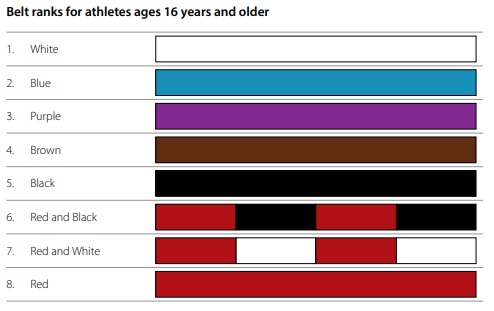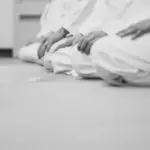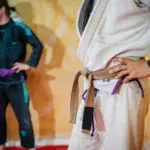Like other martial arts, Brazilian Jiu-Jitsu (BJJ) uses a belt system to determine how well one progresses in their training and their current mastery level. The belt system is slightly different between adult fighters and children.
The adult belt system in Brazilian Jiu-Jitsu is for trainees ages 16 and older. The order of the adult belts is as follows: white, blue, purple, brown, black, coral (red/black), coral (red/white), and red. How much BJJ students master will determine whether they are ready to receive the next belt.
Although the Brazilian Jiu-Jitsu belt system closely resembles other martial arts belt systems, like Judo, there are a few slight differences, especially with adult participants. Below, we’ll review the adult Brazilian Jiu-Jitsu belt system in detail and what is required to receive the next belt to progress.
What Is The Adult Belt System In Brazilian Jiu-Jitsu?
The belt ranking system in Brazilian Jiu-Jitsu is meant to reflect how well a student progresses in their martial art skills. The better you are at certain skills and moves, the quicker you can move up through the belt rankings.
The belts are worn as part of the Brazilian Jiu-Jitsu uniform, and they help identify how well a student is doing with their training schedule.
The adult belt system in Brazilian Jiu-Jitsu is as follows:
- White Belt
- Blue Belt
- Purple Belt
- Brown Belt
- Black Belt
- Coral Belt (Red/Black)
- Coral Belt (Red/White)
- Red Belt

Between the black belt and red belt, there are actually 10 “levels” (also referred to as “degrees”). Starting with the black belt (#0), the belts progress to black belt #6. From there, you move on to coral #7 (Red/Black), coral #8 (Red/White), and then finally onto red belts #9 and #10.
White Belt

The white belt is the first in the Brazilian Jiu-Jitsu adult belt system. This belt is only reserved for those who are just beginning Brazilian Jiu-Jitsu as students. Several trainers of Brazilian Jiu-Jitsu believe that this belt should be for students who do not know any martial arts, while other trainers believe this belt should only be reserved for those who have no knowledge of Brazilian Jiu-Jitsu (but might have other martial arts training).
There is also a divide among trainers and high-level Brazilian Jiu-Jitsu practitioners about what white belt fighters should be learning and focusing on:
- On the one hand, some trainers believe white belts should solely focus on escapes and defensive positions; this is because white belts will almost always be fighting as the inferior fighter, putting them in inferior fighting positions.
- Other trainers believe that a more well-rounded knowledge of basic submissions and guard passes should be the emphasis with white belts. These trainers believe that the newest trainees should have a more general knowledge of Brazilian Jiu-Jitsu before moving on to the next belt.
Blue Belt

The blue belt is the next level in the adult ranking system in Brazilian Jiu-Jitsu. This belt level will be where many practitioners will find themselves either committed to Brazilian Jiu-Jitsu or eventually phasing out of practice. This is because most schools require that a practitioner stays at the blue belt level for a minimum of two years.
The training is still relatively new at this level, with fighters exploring more about Brazilian Jiu-Jitsu and the various holds, grips, and fighting styles. This results in the trainee logging hundreds of hours.
Note: The blue belt is usually recognized in schools that do not use the yellow, orange, and green belts. For schools that do use these other belts, the blue belt becomes the next belt ranking after them; this is often the case for younger students who eventually become of age to participate in adult Brazilian Jiu-Jitsu classes.
Purple Belt

The purple belt is next in the Brazilian Jiu-Jitsu system, although it is, in many ways, similar to the previous blue belt. This belt and the training that goes along with it often cover a wide range of material that the practitioner must learn and master before moving on.
Also, like the blue belt, there is a minimum general time that a person must be practicing as a purple belt before moving on to the brown belt, usually 18 months.
The purple belt is also the level where the International Brazilian Jiu-Jitsu Federation (IBJJF) allows you to begin training younger practitioners. You would have close to three years of experience at this point in training and learned plenty of techniques, probably near 95% of all Brazilian Jiu-Jitsu moves.
Brown Belt

The brown belt comes right before the black belt. At this point in training, through the blue and purple belts, most of the techniques and moves you will need to know have been taught and regularly practiced. But, the brown belt is where students have to prove they have mastered them all.
This level requires you to refine the techniques you have learned and take lessons from more seasoned fighters than you may have been accustomed to previously. In fact, once you reach the brown belt level, you are only allowed to be trained by black belts and higher. You can still train those below you, starting from the white belts up to the purple belt levels.
Like the last two belts, there is a minimum suggested time a practitioner must have with the brown belt before they can move on to the next belt—at least a year. Also, you have to be at least 18 years old to be awarded the brown belt.
Black Belt

The black belt is considered among the highest-ranking of belts in martial arts. Anytime a person is considered a “black belt,” that person has put in years of training to reach that level, and it pretty much makes them a master of their art. To achieve the black belt status, the practitioner must be at least 19 years old and have practiced wearing the brown belt for at least a year, according to the IBJJF.
If a person is a wearer of the black belt, most Brazilian Jiu-Jitsu schools will refer to them as “Professors.” There are some schools, however, that reserve that title for more senior wearers of the black belt.
When it comes to training as a black belt and leveling up, there are many rankings that Brazilian Jiu-Jitsu requires a person to hit before they can move up. Unlike the previous belts, there are up to 10 levels for a “black belt,” with rankings at the seventh and eight degrees (coral belts) and the ninth degree—represented by the red belt. The red belt also signifies the 10th level.
Also, when it comes to black belts, training others is a big part of how practitioners can move up the rankings. This requirement comes from the Brazilian Jiu-Jitsu notion of helping others to achieve greater status. To progress to the next rank in the black belt, the practitioner must practice for at least three years to move up one ranking.
Black Belt Variations
When it comes to the standardization of the black belt, the IBJJF has none, so the decisions of the type of black belt used are generally left up to each individual Brazilian Jiu-Jitsu school. However, you will usually find one of three variations:
- Black Belt with a White Bar – The black belt with a white bar usually means the wearer is a competitor or a practitioner. These martial artists are generally still attempting to move up the belt system and earn a more prestigious belt.
- Black Belt with a Red Bar – The black belt with a red bar is mostly known as the “standard” black belt but can be used to identify a coach from a professor. The professors are the ones leading classes of lower-ranked belts, while the coach is someone who trains lower belts for competitions where two students fight one another.
- Black Belt with a Red Bar and White Borders – The black belt with a red bar and white borders is very well-regarded, signifying that the wearer has been teaching as a black belt for over a year. It can also help differentiate a professor from other black belt wearers.
There is one other black belt variant: the black belt with a blue bar. Royce Gracie and the Valente brothers introduced it in 2015 to honor Helio Gracie; however, many schools do not recognize its significance, so it has not been widely adopted.
Coral (Red/Black) Belt

The coral belt is named after the coral snake because of its look, with the red and black pattern resembling the snake. This belt’s status is similar to other martial arts bodies, such as Judo, where this level is considered the 4th-degree black belt.
The wearers of this belt are some of the most experienced practitioners of Brazilian Jiu-Jitsu. There are not many specific requirements to achieve this belt, like time limits as with previous belts, but the practitioner must impact Brazilian Jiu-Jitsu in a significant way.
- You can be an impactful professor to younger practitioners
- You can promote Brazilian Jiu-Jitsu
- You can continue to work to grow the martial art of Brazilian Jiu-Jitsu
Along with these statuses, those that earn the opportunity to wear the first coral belt are often referred to as “master.” To move up to the next belt, the practitioner must practice at the first coral belt level for seven years.
Coral (Red/White) Belt

The next coral belt is fairly new to the Brazilian Jiu-Jitsu world of rankings. In 2013, the coral belt with red and white was introduced as a stepping stone between the previous coral belt and the red belt.
Like the last coral belt, this one also has similarities to a Judo belt worn at formal occasions by 6th to 8th-degree black belts. To move on to the final red belt, the student must practice and teach at this level for at least 10 years.
Red Belt

This is the rarest of all the Brazilian Jiu-Jitsu belts. According to Renzo and Royler Gracie, this belt is reserved for those whose “influence and fame take them to the pinnacle of art.”
This belt is actually awarded in place of the 9th and 10th levels of the black belt. It is rare to receive this honor; in fact, the number of red belts given out can be easily counted (unlike the other belts). Historically, red belts have been bestowed upon the pioneers of Brazilian Jiu-Jitsu and the Gracie brothers: Carlos, Gaston, George, Helio, and Oswaldo.
The title of one who wears the red belt is “Grandmaster.” There are actually no living Grandmasters currently; the highest belt held is currently a 9th-degree black belt. According to the IBJJF, if a practitioner were to earn the black belt at age 19—and if they were to remain on course through their training—they would reach the red belt status by the age of 67.
Adult Belt vs. Children’s Belt System in BJJ
When it comes to training for Brazilian Jiu-Jitsu, you can start as young as four years old; this is the IBJJF’s recommended age to be when first starting. These belts are starters for any youths practicing Brazilian Jiu-Jitsu and can be a great building block if the practitioner continues training past age 16.
There are four distinct colors of the youth Brazilian Jiu-Jitsu belt system, with each color split up into different levels. The four colors are:
- White
- Yellow
- Orange
- Green
Just like the adults, the youths also start with white as their first belt color. There are three different variations of each belt, starting with the Gray-White belt.
Each new color starts with the color plus white variant of the belt (i.e., yellow-white, orange-white, green-white). Then, the next belt would be the solid color (gray, yellow, orange, green). And finally, it rounds out with the black variant (gray-black, yellow-black, orange-black, green-black).
As mentioned earlier, these youth belts are for ages 4-15. But, also like the adult belts, there are limits to who can be awarded a higher belt color based on the person’s age. The gray belt series is for ages 4-15, the yellow belt is for ages 7-15, the orange belts are for ages 10-15, and the green belts are for ages 13-15.
Once a practitioner reaches 16, they are then eligible for the blue belt and can therefore progress through the entire adult belt system.
How to Progress Through Each Adult Belt in BJJ
There are very few written guidelines and rules when it comes to progressing through the belt system in Brazilian Jiu-Jitsu. The IBJJF does have an extensive graduation system that is based on the practitioner’s membership status at the school and the amount of time they are practicing at each level, but there are no guidelines for promotion based on performance or technique.
For the most part, it is up to each individual school and professor to determine if a practitioner is ready to move up to the next level. Most schools base promotions on how much knowledge of the techniques a student can demonstrate.
There is no real emphasis put on the competitions of fighting between two students in Brazilian Jiu-Jitsu to determine whether they should be allowed to move to the next belt. However, that does not mean that it is discouraged; in fact, it is the opposite.
Brazilian Jiu-Jitsu teachers will encourage students to spar against one another to test their knowledge of the martial art’s moves and techniques in a live combat arena. This can help show a student what actually works in live combat and not just in practice, which can ultimately help them prove their understanding of Brazilian Jiu-Jitsu once they feel ready to move on to the next belt.
Formal Testing
There are a few Brazilian Jiu-Jitsu schools that have a more formal form of testing their students to ensure they are ready to move up to the next rank. Roy Harris was the first to publish formal testing criteria to ensure that each student is judged the same across the lines.
The Gracie System, based on the teachings of the Gracie brothers, also has a formal testing system that allows for in-person and even some video submissions to determine if a practitioner can move up in rank. These tests still consider the knowledge a practitioner must have to move up, but elements like a student’s character and knowledge of the martial art’s history can come into play.
Conclusion
The adult belt system in Brazilian Jiu-Jitsu is a fairly straightforward system that puts students of the martial art into specified categories depending on their skill levels. The system has been in place for several years since it was developed by the founders of Brazilian Jiu-Jitsu, the Gracie Brothers.
The movement between belts is more informal than the system, as each Brazilian Jiu-Jitsu school has its own teachers and professors who have their own judgment for how well or poorly a student is doing. The entire system is based on how well the professors feel the students are doing in their knowledge of the martial art and its different techniques.


